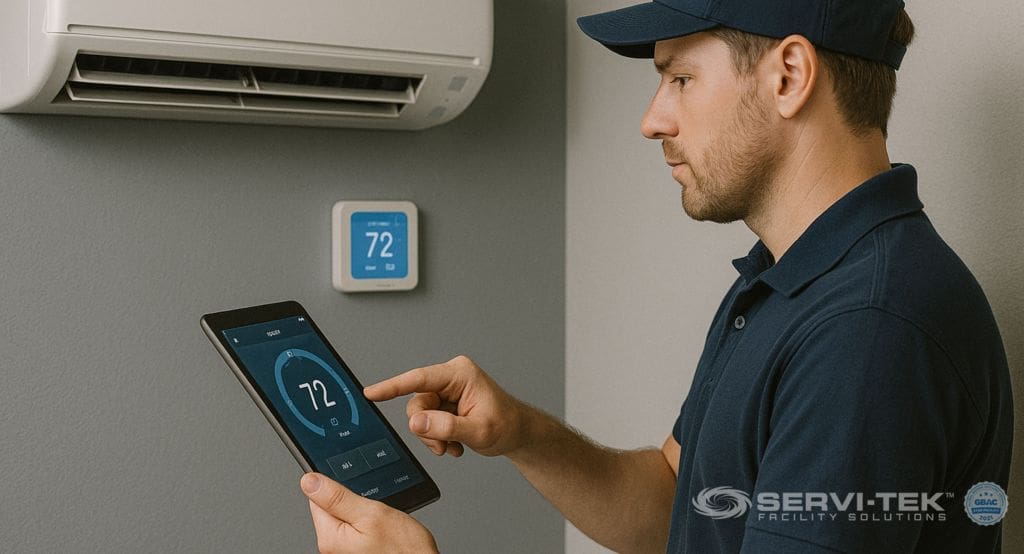For commercial property managers overseeing educational institutions, keeping energy costs low while maintaining a comfortable environment is a top priority. Schools, universities, and other educational buildings require consistent heating, cooling, lighting, and water use throughout the year. However, inefficient systems and outdated technology can drive up utility costs unnecessarily.
Improving energy efficiency in educational facilities not only reduces costs but also enhances sustainability efforts, aligns with regulatory standards, and provides a better experience for students, faculty, and staff. This guide outlines practical strategies for reducing utility expenses without compromising comfort.
1. Smart HVAC Management

Regular Maintenance & Upgrades
A well-maintained HVAC system runs more efficiently and lasts longer. Simple routine tasks can make a big difference in energy consumption:
- Clean and replace air filters regularly to improve airflow and system efficiency.
- Schedule seasonal tune-ups to ensure HVAC components function at peak performance.
- Upgrade to energy-efficient HVAC systems with high SEER (Seasonal Energy Efficiency Ratio) ratings to reduce long-term costs.
Smart Thermostats & Automation
- Programmable thermostats adjust temperatures based on occupancy schedules, reducing energy waste.
- Occupancy sensors detect when rooms are in use and automatically adjust heating and cooling levels.
- Zoned HVAC systems allow temperature control for different sections of the facility, optimizing comfort and efficiency.
Proper Insulation & Sealing
- Seal air leaks around doors, windows, and ducts to prevent energy loss.
- Upgrade insulation in walls and ceilings to maintain indoor temperatures with minimal HVAC usage.
- Install energy-efficient windows that reduce heat gain in summer and heat loss in winter.
2. Optimized Lighting Solutions

LED Lighting Upgrades
- Replace outdated fluorescent and incandescent bulbs with LED lighting, which uses up to 75% less energy and lasts significantly longer.
- LEDs provide better lighting quality, reducing eye strain and improving learning environments.
Daylight Harvesting & Sensors
- Install motion sensors in classrooms, offices, and hallways to ensure lights turn off when spaces are unoccupied.
- Utilize daylight-responsive controls to dim artificial lighting when natural light is sufficient.
- Maximize natural light by using reflective surfaces and light-colored walls to distribute daylight more effectively.
3. Water Conservation Strategies

Efficient Plumbing Fixtures
- Install low-flow faucets, toilets, and urinals to reduce water usage without affecting performance.
- Use touchless fixtures to prevent unnecessary water flow and improve hygiene in restrooms.
Smart Irrigation Systems
- Weather-based irrigation controllers adjust watering schedules based on real-time weather conditions.
- Drip irrigation systems deliver water directly to plant roots, minimizing evaporation and runoff.
- Use native and drought-resistant landscaping to reduce outdoor water needs.
4. Building Automation & Energy Monitoring

Smart Building Systems
- Building Management Systems (BMS) allow real-time monitoring and control of lighting, HVAC, and security systems from a central dashboard.
- Energy monitoring software tracks usage patterns and identifies areas for improvement.
Peak Demand Management
- Shift high-energy activities (e.g., heavy equipment use) to off-peak hours when electricity rates are lower.
- Utilize battery storage and backup power systems to manage demand spikes and prevent excessive utility charges.
5. Renewable Energy Integration

Solar Power & On-Site Generation
- Install solar panels to generate renewable energy and reduce dependency on the grid.
- Explore net metering programs to sell excess energy back to the utility company, further offsetting costs.
Energy-Efficient Windows & Roofing
- Reflective roofing materials reduce heat absorption, keeping buildings cooler in warm climates.
- High-performance windows improve insulation, reducing heating and cooling loads.
6. Employee & Tenant Engagement

Workplace Energy Awareness Programs
- Educate faculty, staff, and students on simple energy-saving habits, such as turning off unused electronics.
- Implement green initiatives, such as recycling programs and sustainability challenges.
Sustainable Work Policies
- Offer telecommuting and flexible schedules to reduce the need for heating, cooling, and lighting during non-peak hours.
- Encourage paperless operations to cut down on unnecessary printing and power consumption.
What’s Next?
Reducing energy costs in educational facilities doesn’t have to come at the expense of comfort. By implementing smart HVAC strategies, optimizing lighting, conserving water, integrating automation, and considering renewable energy options, schools and universities can significantly cut utility expenses while maintaining a healthy learning environment.
At Servi-Tek Facility Solutions, we specialize in sustainable facility maintenance, helping institutions across Hawaii, California, Utah, Colorado, and Arizona implement cost-effective energy-saving solutions. Our team is dedicated to improving operational efficiency while ensuring a comfortable and compliant facility.
Looking to lower your utility costs? Schedule a consultation with our facility experts today!



